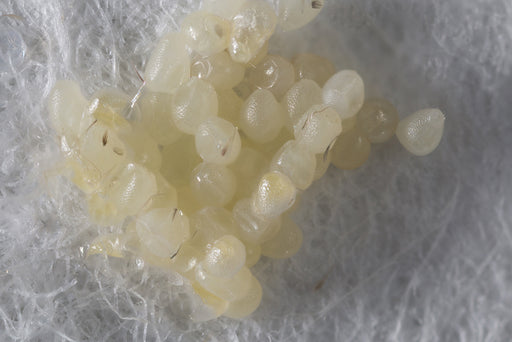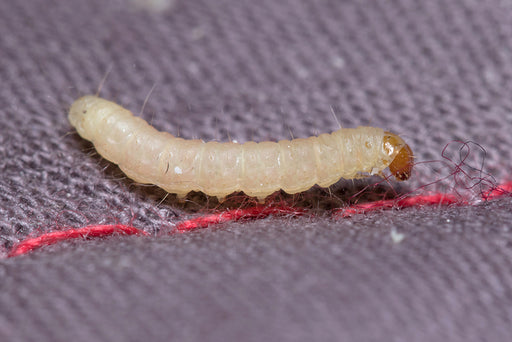Small White Worms In or Under Clothes

Seeing tiny white worms in clothes can be a disturbing and unwelcome experience. After all, even mentioning worms in clothes is pretty darn gross. Who wants to open up their dresser and see that creepy crawlies have nested there? Yuck!
So what can you do and why is this happening? The answer is probably that you have Clothes Moths, but there could be other causes as well. Here, we’ll go over what you need to know about moth worms on clothes and more. That way, you can get everything taken care of and prevent this from ever happening again!
Be Certain to Identify the “Worms” Correctly
To get rid of gross insects in your home, you will need to first identify what you are dealing with correctly. Worms and caterpillars are very different. Clothes Moths start as larvae (caterpillars) and grow into moths later. However, we understand your confusion, because these caterpillars are pretty worm-like in appearance. Apart from Clothes Moths, other insects can get into your home and lay eggs as well. If you have food stored near your clothes, for instance, you could be dealing with any number of pests.
Fly Larvae can look like worms and many other insects start as larvae as well. So, first, make sure you are dealing with Clothes Moth Larvae. If you are, the extermination process is pretty straightforward. It involves diligence, getting the right tools for the job, and taking measures to prevent reinfestation in the future.
Moth Worms That Eat Clothes: The Basics
Worms aren’t exactly one of nature’s cutest creatures. Therefore, finding them crawling through your sock drawer is probably not what you want to be dealing with when you are trying to get dressed. Still, if you uncover what appear to be white worms in your wardrobe, you aren’t alone. Most likely, these tiny white worms are the larvae of Clothes Moths. These larvae eat animal-based fibers and are a real pest!
The Good News
Believe it or not, there’s good news about the situation. If you are indeed dealing with Clothes Moths, chances are, you can fix your problem with some perseverance. In fact, if the larvae are still small and white, you might even have found an infestation in its early stages. This may indicate that you will be able to prevent some (or a large) amount of damage to your clothes. At the very least, you can prevent even more damage from taking place and protect your home. So as gross as it seems, at least you are now in the know and can get this handled!
The Bad News
Now for the bad news. If you find the “worms” of a Clothes Moth, you should know that the infestation could easily spread. If ignored, you could be finding worms like this all over your house. Therefore, you will need to solve this issue right away.
Clothes Moth Larvae Facts
Clothes Moths are common closet pests that enjoy a nice undisturbed dark corner full of animal-based fabrics. If, for instance, you have woolen socks in a rarely used drawer, a female adult Clothes Moth may settle there.

At this stage, the female Clothes Moth lays tiny eggs that are hard to see. Nearly microscopic, the eggs stick to the insides of drawers, closet corners, clothes, etc. In time, these eggs hatch into (you guessed it) gross tiny white worms. These "worms" are technically the caterpillars of the Clothes Moth.
Technically, These Worms are Actually Larvae
These little white worms are Clothes Moth Larvae. This means that they will keep growing and changing until they turn into adult Clothes Moths. Clothes Moths Larvae eat animal-based fibers which contain the protein keratin. They will also eat materials such as cotton if they are soiled with sweat or blood stains.
Keratin can be found in wool, silk, feathers, cashmere, and more. This consumable material is the perfect food source for moth larvae. As the larvae eat, they grow and may change color. Clothes Moth Larvae will eventually go through a pupal stage and then undergo metamorphosis into the final adult moth stage.
Identifying Clothes Moth Larvae is Fairly Straightforward
Clothes Moths belong to the family Tinea Pellionela. In color, Clothes Moth Larvae start off white with darker colored (usually brown) heads. They are about 10mm long. These larvae can feed on all kinds of organic matter. This includes carpets and clothing. Wool is a favorite, but soiled linen and cotton are not out of the realm of possibility. They usually avoid synthetics but can damage them as they chew holes through other materials.
Treating Clothes Moth Infestations in the Larval Stage
Clothes Moth Larvae are terrible pests that can wreak serious havoc if left unchecked. If you find Clothes Moth Larvae in your home, you should start dealing with the infestation right away. Try to find the source of the problem and be sure to treat and clean all nearby areas as well. This will help you remove any hidden eggs or cocoons.
Check under dressers, behind drawers, in dark crevices, and anywhere else you suspect eggs could be hiding. Using a moth-killing spray is one route to take, you can refer to our Clothes Moths Kit Guide for further information . You may want to fumigate a room and then wash the clothing items afterward. There are many approaches to take when dealing with a Clothes Moth infestation and the way you choose to proceed should be based on your unique situation.
The Dos and Don’ts Dealing with Clothes Moth Larvae

Now, let’s go over what you should avoid doing if you have discovered tiny white worms in your clothing items and have determined that you have a Clothes Moth problem. That way, you can avoid making regrettable mistakes.
Do not bring infested items out into the rest of your home
Clothes Moth infestations are generally localized, at least at first. Nevertheless, they can and will spread if left untreated. As such, it is important to prevent an infestation from spreading if possible. This means keeping infested items in the same general location and dealing with each problem area in order. Don’t move the whole dresser into your hallway or start tossing clothes into a hamper. Instead, treat the area as a quarantine zone.
Remove infested clothes in airtight plastic bags. You can freeze bags of clothes for 72 hours to kill Clothes Moth Larvae before washing the clothing items. If you need to throw things away, make sure to take infested item bags far away from your home. This could mean making a dump run. Clean furniture and all items thoroughly before letting them leave the room.
Do not start the pest control process until you have the right tools
Do not bring clothes or furniture out of a room until you have treated everything for Clothes Moths. It is also important to bag everything up properly to prevent the infestation from spreading. To do this, you will probably need a few things.
Do arm yourself with some (or all) of the following items:
- Moth killing spray
- Moth bombs/fumigation products
- Vinegar water spray bottle
- Scrub brushes
- Plastic trash bags
- A vacuum cleaner
- A broom
- A mop
- Moth deterrents (herbal sachets, cedar shelving)
After treating the moth larvae infestation you may like to consider using MothPrevention Clothes Moth Traps so that you can monitor for any further moth activity. Position these in areas where you have seen adult moths flying around and they will help break the breeding cycle by eliminating the adult male moths.
Do not ignore the problem
Ignoring a moth larvae infestation will not make things better. The longer you let this go on, the worse things are likely to become.
Do handle an infestation in the right order
Treating an infestation of Clothes Moths should be done in the right order. The process involves identification, elimination, sanitation, preservation, and prevention. Here’s what that looks like.
Do know the steps of extermination
- Identification - This involves identifying that you are dealing with actual Clothes Moth Larvae.
- Preparation - Get the right tools for the job before you launch your extermination campaign.
- Sanitation - Thoroughly clean the area and bag up any clothes you want to save
- Elimination - Then, use moth detecting pheromone MothPrevention Clothes Moth Traps to monitor for the presence of moths and catch the active adult males. Use sprays or fumigation to kill larvae, eggs, and adults.
- Elimination - Then, use moth detecting pheromone MothPrevention Clothes Moth Traps to monitor for the presence of moths and catch the active adult males. Use sprays or fumigation to kill larvae, eggs, and adults.
- Preservation - Save what you can. Freeze clothing for at least 72 hours to kill moths and then wash or dry-clean everything.
- Prevention - Figure out how the Clothes Moths came into your house in the first place and take this route away.
How to Get Rid of Clothes Moth “Worms” (Larvae) and Prevent Re-infestation
Now, let’s run through what eliminating a Clothes Moth infestation is actually like in real life. For example, let’s imagine you just found white worm-like Clothes Moth Larvae in, say, a dresser. You open up a rarely used dresser drawer and see them all over your socks and mittens. So, the first thing to do is be sure you have identified the right pest.
- Different insects have to be dealt with in different ways. If you are sure that you have Clothes Moths, you should get the right Moth Traps and insecticides to treat the problem. Fumigation is one of the easiest routes, but this method isn’t for everyone. If you want to go with a more natural alternative, vinegar and water combined with rigorous cleaning and using a freezer may be helpful.
- If you are sure you are dealing with Clothes Moths, it’s time to get the right tools for the job as listed above. In the meantime, keep that room sealed off and leave everything in there alone. When you have the right arsenal of tools prepared, it’s time to identify any other hiding places because there’s a good chance that there could be larvae in other clothes drawers, behind shelves, in carpeted areas, and undisturbed dark nooks and crannies.
- Now, it’s time to start the elimination process. As you may have guessed, this will involve bagging up infested clothes, vacuuming thoroughly, scrubbing down furniture, rigorously wiping down and cleaning areas where moths have been present, and so on. Remember to keep everything contained and get in all the cracks and crevices. Then, if you fumigate a room, be sure to proceed with care and follow all instructions to the letter to protect any pets, kids, and yourself. Before fumigating you may like to read our Clothes Moth Kit Guide for information on how to use chemical products in line with our Traps to rid your home of Clothes Moths.
- After everything is cleaned, sprayed, and laundered, you should try to figure out how the moths got in. Were there eggs carried in unknowingly, concealed in the fabric of a used piece of furniture from a thrift store? Did you leave any windows open at night and an adult female flew in? Are there moths elsewhere in your home? If you can figure out how moths got into your house initially, you can prevent them from coming back. However, it isn’t always that easy. Do what you can, and treat your home thoroughly.
- When this has all been handled, you should use moth detection methods going forward. After all, if you had moths once, you could get them again. Who wants that? Position Clothes Moth Traps to monitor for any future presence of moths. The Traps will also help break the breeding cycle, by attracting the adult male Clothes Moths to the sticky pheromone strips. Hanging herbal sachets full of lavender, thyme, rosemary, and cloves may sound like a smart solution, but this isn't to be done in combination with using pheromone moth traps. Cedar is considered the best of these deterrents / repellents so, if you have a recurring Clothes Moth issue, you could consider installing cedar shelves, dressers, and other cedarwood furnishings. A less costly and impacting approach than changing your furnishings would be to hang pheromone clothes moth traps all year round.
FAQs About Moth Larvae and Moth Worms on Clothes
Now that you have the basics, let's go over some frequently asked questions on the subjects of Clothes Moth worms (larvae), and other wormy pests that get into clothes. After all, the more you know, the better you can handle an issue of this kind.
What causes worms in clothes?
There are many reasons that you could be getting wriggly white worms in your wardrobe. However, the most likely reason is the Common Clothes Moth. Clothes Moths lay eggs that hatch into larvae. In the earliest stages, these larvae are white, yellow, or tan with brownish heads.

Clothes Moth Larvae eat materials that contain animal-based fibers. These can include wool, silk, feathers, leather, and more. Sometimes, they also eat cotton or other materials. If linen items are soiled or stained with food, larvae may go after them. They chew holes through clothes as they grow and mature. Then, they spin cocoons and emerge as adult Clothes Moths. From here, they mate and the cycle perpetuates.
Clothes Moth Larvae in clothing do not indicate that your clothes are dirty. Though they can be attracted to soiled clothes, they like clean clothes just as much. These pests seek a protein called keratin as their primary food source. Keratin is found in animal-based fibers such as wool and silk. The main things Clothes Moths like are dark places, quiet and secluded areas. And when these conditions are available with a food source nearby, a female Clothes Moth will often lay eggs.
How do you get rid of worms in your clothes?
Eliminating Clothes Moth Larvae involves identifying your problem areas and treating them with insecticides. However, natural methods like vinegar and water sprays and freezing clothes for 72 hours in the freezer may also be effective. You should also clean and scrub down the entire area and vacuum thoroughly.
How do I get rid of Clothes Moth larvae?
To get rid of Clothes Moth Larvae, you can freeze any infested clothes for 72 hours. Then, wash or dry-clean all items. In areas where you see or suspect that moths are present position Moth Defense Clothes Moth Traps to intercept the male moths before they can breed. Fumigation and clothes moth killing sprays can also be effective. There are many ways to eliminate Clothes Moths. The trick is to be thorough. Then, be vigilant to prevent an infestation from reoccurring.
What do larvae look like on clothes?
Clothes Moth Larvae are usually light yellow, white, or tan. They have segmented bodies and dark-colored heads that can be tan to dark brown. They are most often about 10mm (¼ inch) long but may be smaller, depending on what stage of growth they are in. To identify Clothes Moth larvae, look for small caterpillar-like insects.
Moth larvae casings, holes in clothes, dead adult moths, and dried cocoons are other tell-tale signs. However, if the moth larvae are recently hatched, they may not have done much damage to your clothing items yet.
About MothPrevention
MothPrevention® speak to customers every day about their clothes moth issues - clothes moths are a species that are ever increasing and that can cause significant damage to clothes, carpets and other home textiles.
To date, we’ve helped over 250,000 customers deal with their moth problems. We have developed professional grade solutions including proprietary pheromones and trap design, not available from anybody else in the USA.





